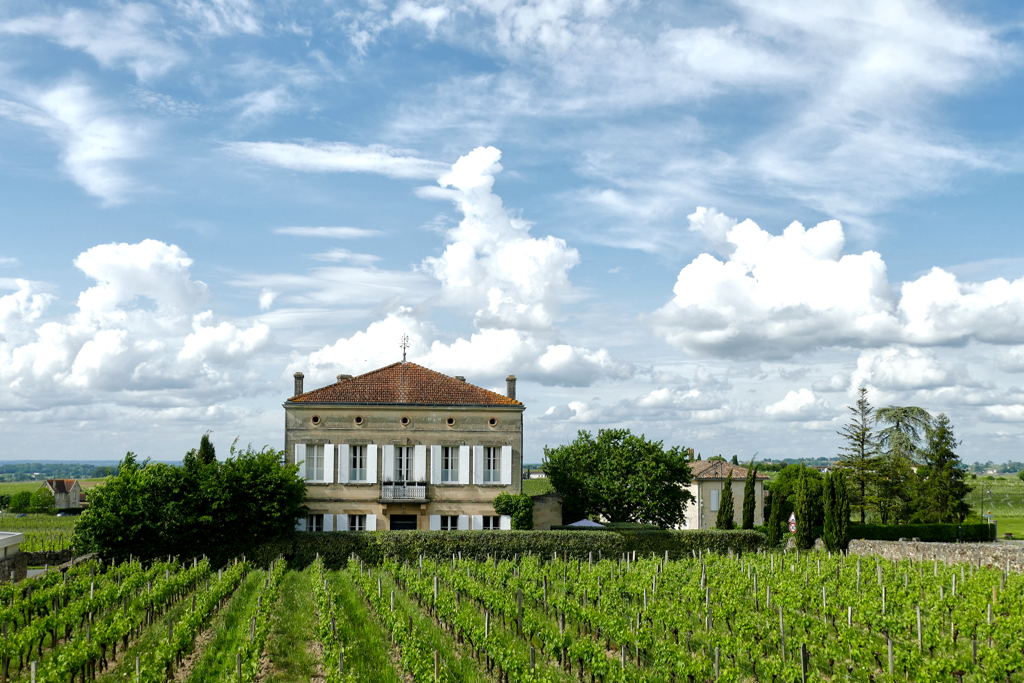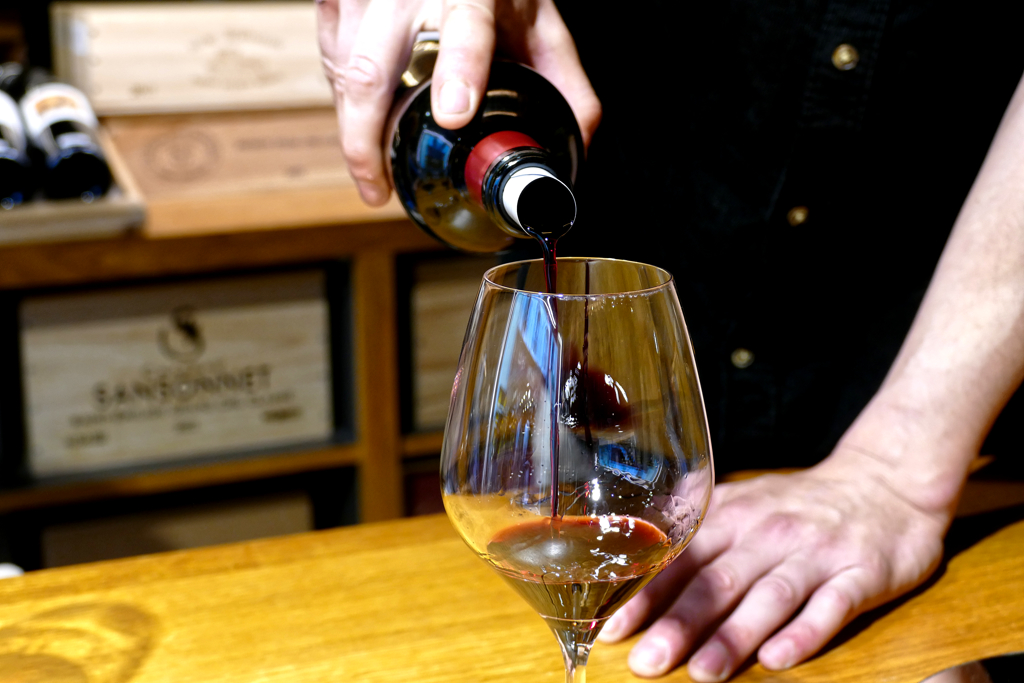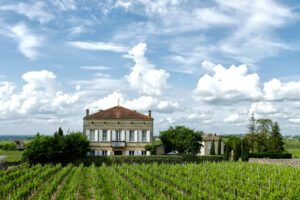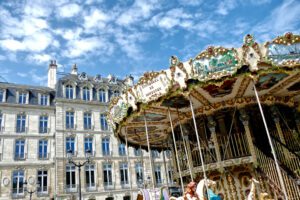Saint-Émilion is a breathtaking blend of sun-drenched vineyards and medieval charm. Every winding alley and every old stone building tells a story. Whether you’re a history buff, a wine lover, or looking for the epitome of the Southern French way of life, here’s a perfect guide for a day trip to the charming village of Saint-Emilion. I promise you an unforgettable experience!

Saint-Emilion – Carved from Stone
In the 8th century, a Breton monk decided to settle in the area. The villagers revered him as a benefactor and miracle worker, and he quickly gained numerous followers. To this day, Saint Émilion remains the patron saint of the small town named after him.

Because the region lay on the Way of St. James, Benedictine and Augustinian monks founded small monasteries in the 12th century, around which the village subsequently developed. Although the village survived the Hundred Years’ War unscathed, the religiously motivated conflicts during the Huguenot Wars in the 16th century caused lasting damage.
Strictly Rural
In the past, the villagers lived self-sufficiently off the land. The vineyards that had existed since ancient times were interspersed with fields full of fruit and vegetables.

However, the residents also earned a considerable income by quarrying stone in underground tunnels. These stones were used for local house construction and also sold to nearby Bordeaux. The fact that these shafts could have disastrous consequences to this day is the flip side of the coin.

Either way, today, Saint-Émilion is one of the most famous and significant wine-growing regions in all of France. As we all know from the Asterix books, the Romans occupied Gaul. On a positive note, they brought viticulture with them. Hence, with more than 1,000 vineyards spreading over an area of 5,400 hectares, winemakers around Saint-Émilion have been producing wines from grapes and passion for centuries. Saint-Émilion was deservedly declared a UNESCO World Heritage Site in 1999, actually the first wine-growing region in the world.
It’s no wonder that the town’s cultural and natural treasures attract enthusiastic and passionate visitors from all over the world!
Fun Fact
On the Greenwich Meridian, Saint-Émilion lies exactly halfway between the North Pole and the Equator!
The Monolithic Church of Saint-Émilion
On a Monday morning, a multinational group of people gather, mostly in couples, in front of what looks like the main entrance to a Gothic church. Then Maëva, an energetic woman in her early twenties, arrives. She explains to us in fluent English, adorned with a charming French accent, that this isn’t the entrance to the famous Monolithic Church, what the church really is, and that we’re about to see four important parts of this unique building. As she does so, she rattles a set of keys, which she will use to unlock and then carefully lock each individual section we visit.

The fact that we don’t simply march past a guard is because we’re trespassing on private property. Incredibly, the Monolithic Church of Saint-Emilion doesn’t belong to the city. No, it’s in fact privately owned! But who on God’s green earth buys a church building?
“After the French Revolution, which also brought with it a temporary de-Christianization, a winemaking family acquired the complex. For a time, parts of it were actually used for their wine trade,” explains Maëva. The fact that the church is privately owned is also the reason why photography or filming isn’t allowed inside.
But what exactly is a monolithic church? Well, a monolithic church is a church hewn from natural rock. The name comes from the Greek word monólithos, loosely translated as uniform stone.
Going Down
Maëva unlocks the first door and leads our group down a steep staircase into a damp stone chamber where the Breton hermit Saint Emilion set up camp in the 8th century. Apparently, the whole town then readily adopted his name. As we stand there in this cold underground chamber, Maëva draws our special attention to a small ledge in the wall. “That’s the famous Seat of Fertility. Every year, the tourist information office receives thank-you letters from pregnant women who have sat on it. Well, I’m definitely not sitting on it,” she declares, almost panic-stricken, taking a few steps to the side just to be safe.
We climb the stairs up again, Maëva locks the door, and leads us to the next entrance. Here, we enter the Trinity Chapel. Saltpeter had covered the walls of this small church for decades. Funny enough, this way, it formed a protective layer that shielded the beautiful medieval frescoes from the elements so that they still enchant us today.

Next, we head back into the depths, namely into the catacombs, in whose ghostly labyrinth the sarcophagi can still be admired today. A hole in the rock ceiling is said to have allowed the souls to escape.
A High in the Low
But the highlight, of course, is a visit to the underground church building. Only the high windows, which are actually at street level, reveal how deep we are. The monolithic church is a rare and impressive example of medieval rock-cut architecture and a symbol of the city’s identity. But that’s not the only reason why Saint-Émilion is making every effort to preserve this unique architectural masterpiece.

Obviously, a great deal of stone was removed to create the catacombs and the church. This stone was then sold, among other places, to nearby Bordeaux, where the magnificent buildings that can still be admired today were built. In—or rather, beneath—Saint-Émilion, this stone is missing today. If the underground passages and rooms collapse, they would sweep the entire village away. A terrible thought. I hope Saint Émilion continues to hold its protective hand over Saint-Émilion.
Going Up
A bell tower was much later built over the monolithic church. It reflects the various construction phases, from Romanesque to Gothic. You could climb it via 196 steps and have a fantastic view of the city and the entire idyllic surrounding area.

Yet, since I’ve already been climbing up and down Saint-Émilion’s picturesque, but in places extremely steep, cobblestone streets for two days, I’ll skip it today.
Tour du Roy
The Tour du Roy stands on the edge of a plateau and is separated from the lower part of the town by a deep ditch hewn into the rock. Contrary to its name, this tower is by no means royal. Nevertheless, it is one of the town’s landmarks. Built around 1230, it is the former municipal belfry. At its foot stood the medieval town hall of Saint-Émilion until 1720.
To enjoy the marvelous panoramic view, you have to pay 2 €uros, but more importantly, you need to climb 118 steps of a spiral staircase. In the summertime, the tower is open every day from 2 p.m. to 5 p.m. During the rest of the year, it’s only open on weekends, and in winter, it’s completely closed. It’s best to check the opening times on Google before your visit.

Behind the Tour du Roy, on the large plot of land now planted with vines, there was an Ursuline convent until the beginning of the 19th century. It was built in 1630 to revive the Catholic faith and was thus a symbol of the Counter-Reformation. After the dissolution of the convent, a gendarmerie school was established in the large building.
Legend has it that the traditional macarons of Saint-Émilion originated in the monastery after the French Revolution, when Sister Boutin sought refuge there and, in exchange for room and board, revealed her secret almond recipe. These macarons, which, incidentally, have nothing in common with the well-known filled version, remain a local delicacy to this day and make a truly unique souvenir.
Grandes Murailles
Talking about cultural heritage: The so-called Grandes Murailles, or Great Walls, are the only remaining remains of a former Dominican monastery dating back to the 12th century.
Architecturally, one of the rules for a Dominican monastery was that buildings could not exceed a certain height. Traditionally, the Dominicans were mendicant friars. That is, they lived primarily on donations. However, this high section of wall suggests that the mendicant friars of Saint-Émilion may not have been as poor as their order demanded.

At the beginning of the Hundred Years’ War, French troops fighting to maintain their king’s power sought refuge in the monastery. It became a place of refuge, an observation post, and a defensive position. The Dominicans no longer felt comfortable or safe there. They left their monastery and settled within the city walls of Saint-Émilion.
In the fighting between France and England, the building was ultimately almost completely destroyed. Today, only this beautiful section of wall remains. The church ruins, now picturesquely situated amidst vineyards, have been recognized as a historic monument since 1957.
Vineyards
The narrow cobblestone alleys, the streets that seem to have been built for an old movie, the medieval architecture—all that’s all well and good, but what is this really about?
The wine, of course!

It’s the seemingly endless vineyards, the traditional wineries, the hard work and passionate love for wine that has made this small town world-famous.
Château La Gaffelière
As soon as you leave Saint-Émilion’s small train station, which strictly speaking consists of a small building and a barrier in the middle of fields, you find yourself at the edge of the first vineyard.

Château La Gaffelière is not just any estate. Nestled on the southern slope of the village, right where the Saint-Émilion limestone plateau starts to dip, this château isn’t merely about fine wine, but a story of legacy, limestone, and liquid artistry. It has been in the hands of the Malet Roquefort family for over 300 years, which makes them one of the oldest continuously wine-producing families in Bordeaux.
La Gaffelière’s 22 hectares of vines sit beautifully on the famed limestone plateau and clay-limestone slopes, some of the most coveted plots in all of Saint-Émilion. This natural amphitheater-like setting gives the wines depth, elegance, and a fine mineral thread. With around 70 percent, the grape blend is typically Merlot-heavy. Cabernet Franc adds structure and spice. The result is a wine that’s velvety yet vibrant, earthy yet elegant.

La Gaffelière is classified as a Premier Grand Cru Classé B in the Saint-Émilion classification, a status that speaks to both quality and prestige, obviously.
As you visit, don’t miss out on the treasure hidden underground, where there is an ancient Gallo-Roman cellar carved into the stone stemming from Roman times!
Château Saint Georges – Côte Pavie
Directly across the street from La Gaffelière is Château Saint Georges – Côte Pavie. It is one of those lesser-known gems, and while it may not make headlines like its famous neighbors on the Pavie hillside, it certainly holds its own.

Côte Pavie is one of the most prestigious terroirs in all of Saint-Émilion. The limestone and clay soils of this slope are a viticultural dream, giving the vines just enough struggle to produce grapes of depth and complexity.
Château Saint Georges isn’t a sprawling palace or a pretentious tourist trap. It’s a quietly confident estate that combines traditional architecture with a deep-rooted dedication to winemaking.
The wines of Château Saint Georges – Côte Pavie are typically blends dominated by Merlot, with Cabernet Franc and sometimes a whisper of Cabernet Sauvignon. This results in a rich, velvety texture, bursting with ripe red fruits, hints of spice, and that signature Saint-Émilion minerality from the limestone soil.
It’s still a bit of an insider’s secret, not trying to impress with opulence or limited edition bottlings. Instead, it focuses on consistently delivering excellent wine that reflects the heritage of the land it comes from.
Clos Badon Thunevin – Le Garage
Now, Clos Badon Thunevin – Le Garage is not just a vineyard, it’s a bold, brilliant chapter in the history of local wine, penned by none other than Jean-Luc Thunevin, the rebellious maestro who turned the conservative world of Saint-Émilion upside down.

Tucked away in the prized hillsides of Saint-Émilion, Clos Badon is a small, 6.5-hectare estate. In the vineyard, you’ll find mainly Merlot, complemented by Cabernet Franc and a touch of Cabernet Sauvignon, hence, the classic trio. But the real story is less about what’s in the soil and more about who’s behind it.
New Kid on the Block
Thunevin began as a Bordeaux outsider, literally and figuratively, in the early 1990s. He had no family château, no historic lineage, and no Grand Cru Classé credentials. But what he certainly had was ambition. And he had a garage. Which is where various successful stories started, as we know.
It was in that garage that he created his now-famous Château Valandraud.
Hence, Thunevin became the poster child of the so-called garage wine movement that refers to tiny batches of wine made in makeshift cellars, often literally garages, by winemakers who shun tradition in favor of quality over quantity. Thunevin’s Le Garage is more than a nickname. It’s actually a badge of honor for those who believe greatness doesn’t require a château on a hill.
Because eventually, this garage wine shocked the wine world by outperforming First Growths in blind tastings. To this date, Clos Badon is Thunevin’s more classical but still very personal interpretation of Saint-Émilion terroir. It’s produced organically, hand-harvested, and meticulously crafted.

In the glass, you’ll get rich dark fruits, supple tannins, and that luxurious mouthfeel that makes Bordeaux lovers swoon. It’s bold without being brutish.
So whether you’re touring the cobbled streets of Saint-Émilion or browsing a savvy wine list, Clos Badon Thunevin – Le Garage is a name to remember. It’s where tradition meets rebellion aged in oak and served with attitude.
Cloître des Cordeliers
In the heart of the village lies a place where time slows down, stone whispers stories, and sparkling wine flows like poetry. Le Cloître des Cordeliers is a 14th-century Franciscan cloister. This is where Gothic heritage meets effervescent indulgence.

Built around 1338, the cloister was once home to the Cordeliers, obviously, a branch of the Franciscan order known for their simple brown robes and vows of poverty. Despite their modest lifestyle, the Cordeliers ended up with a rather magnificent piece of real estate. Surrounded by lush gardens and arcaded stone galleries, the cloister served as a center for spiritual life until the French Revolution. Then the monks were expelled, and the site was abandoned.
New Purpose
Nevertheless, the Cloître des Cordeliers found a second, equally captivating function.
Beneath the cloister lies a vast network of underground limestone cellars, carved out of the rock long ago. This proved to be ideal for aging wine. Therefore, in the 19th century, enterprising locals realized that these cool, humid tunnels were perfect for producing crémant. Thus began the Cordeliers’ modern-day legacy, namely, traditional-method sparkling wine. In fact, it is the same double fermentation method as used for Champagne.

Today, their Crémant de Bordeaux is a reason alone to visit. You can sip on a flute of crisp rosé or brut in the lush cloister garden under the shade of an ancient tree, surrounded by medieval serenity.
However, the Cloître des Cordeliers is also a cultural hub. From jazz concerts to art exhibitions, poetry readings to wine-pairing picnics, the space hums with life and creativity.

You can even hop on a guided tour to descend into the subterranean cellars and learn how those precious bottles are turned, corked, and aged. Or grab a gourmet picnic basket from the on-site shop, and enjoy your own slow afternoon in the beautiful surroundings.
Clos Fourtet
Hidden away within the medieval walls of Saint-Émilion lies Clos Fourtet, a Premier Grand Cru Classé winery that seems like something out of a fairytale and is aged in oak barrels. Here, the vines stretch like green velvet across sun-drenched limestone soils. At its center stands a magnificent 18th-century château, as noble as the wine it produces.

But Clos Fourtet isn’t just a pretty face. It’s a historic gem with roots dating back to the Middle Ages, when it was a fortified fortress. Indeed, the name “clos” describes an enclosed vineyard. Beneath its vines lies a labyrinth of underground limestone quarries, where the wines mature in near-complete silence. These ancient cellars, dug by hand centuries ago, now serve as the perfect cradle for some of Saint-Émilion’s finest red wines.

The wine is powerful and rich in Merlot, with fruitiness and earthy minerality.
Clos Saint-Julien
Clos Saint-Julien is one of those hidden gems in Saint-Émilion that whispers more than it shouts. It’s a small, soulful winery with an outstanding reputation. Nestled on the hillside just outside the village, this tiny Grand Cru winery stands for a love of tradition and artisanal excellence.

Owned by the Julien family, Clos Saint-Julien covers just under two hectares. But don’t let its size fool you! What grows here is pure magic. The vines, perched on limestone cliffs and carefully tended, produce low yields but plenty of character. Merlot and Cabernet Franc grow here, full of earthy elegance, velvety tannins, and a minerality reminiscent of the rock.
Traditional, organic viticulture is practiced without chemicals and with meticulous care. Harvesting is done by hand, as winemaking here is more of an art than an industry. Thus, only a few thousand bottles are produced each year. If you can get one, take advantage of it.

A visit to Clos Saint-Julien isn’t about grand tours or flashy tasting rooms. It’s about walking through the vineyards, touring the cellar, and hearing stories directly from the people who live there. If you’re a wine lover who prefers authenticity over hype, this is the place for you.
Maison Galhaud
Maison Galhaud is a historic, family-run winery with a legacy dating back to 1901. Léon Galhaud founded the estate and then passed it down through generations. Each of them added to its rich heritage. Léon Galhaud’s son Jean-Jacques expanded the family’s reach by promoting AOC wines globally and was a pioneer in wine marketing. Then Jean-François, the third generation, revitalized the family vineyards in 1996, focusing on producing Saint-Émilion Grand Cru wines like Château La Rose Brisson, Moulin Galhaud, and Château La Haute Rouchonne.

Maison Galhaud is renowned for its monolithic cellars. Those are ancient limestone quarries now serving as ideal aging environments for their wines.
On guided tours, visitors can explore the historic cellars and learn about the winemaking process. You also get to discover remnants of a medieval chapel and grain silo. Obviously, there are also different wine tasting options.
Their Moulin Galhaud, made from 95% Merlot and 5% Cabernet Franc, aged in new French oak barrels, has received multiple awards. Another esteemed Grand Cru, reflecting the family’s commitment to quality and tradition, is Château La Rose Brisson.
Château La Serre
Château La Serre is a distinguished Grand Cru Classé estate. It is renowned for its rich history, exceptional terroir, and elegant wines.
The origins of Château La Serre trace back to the 15th century. However, the current château was constructed in the late 17th century by Romain de Labeyme, a member of a prominent Bordeaux family. In 1956, Bernard d’Arfeuille acquired the estate, and it remains under the guidance of the d’Arfeuille family today, with Luc d’Arfeuille at the helm.

The estate has a size of 7 hectares and is located just 200 meters from Saint-Émilion’s medieval town walls, on the eastern edge of the limestone plateau.
Château La Serre employs traditional winemaking techniques such as fermentation in concrete vats. The wine then ages for 12 to 18 months in French oak barrels.
The chateau’s wines are characterized by their elegance, freshness, and mineral complexity.
The annual production is around 30,000 bottles, and the wines are available outside of France in European as well as non-European countries.
Château TrotteVieille
Château TrotteVieille is one of Saint-Émilion’s most historic and distinctive wine estates, renowned for its deep heritage, unique terroir, and elegant wines.
The estate’s documented history begins in 1453, making it one of the oldest in the region. The name TrotteVieille is steeped in local legend as it’s said to originate from an old woman who regularly trotted down to the nearby post house to gather news. This earned her the nickname La Trotte Vieille, hence the old trotting lady.

Over the centuries, Château TrotteVieille changed hands multiple times. In 1947, it was acquired by Marcel Borie, head of the Bordeaux wine merchant house Borie-Manoux. After his passing, the estate was managed by his son-in-law Émile Castéja, and later by Philippe Castéja, who continues to oversee it today.
Remarkably, Château TrotteVieille is home to a parcel of pre-phylloxera vines over 130 years old which is a rarity even to Bordeaux standards. These ancient vines have survived the phylloxera epidemic that devastated European vineyards in the late 19th century. Wines produced from these vines are extremely limited and typically reserved for very special tastings at the estate.
Obviously, Château TrotteVieille offers guided tours and tastings by appointment. Visitors can then explore the historic cellars, learn about the estate’s winemaking practices, and sample its acclaimed wines. However, the estate also hosts gourmet experiences, including prestigious dinners in its specially designed tasting room.
Château La Clotte
Château La Clotte is one of Saint-Émilion’s hidden gems. The estate is nestled into the limestone slopes, just steps from the village center. This boutique winery belongs to the renowned Vauthier family, the masterminds behind Château Ausone. It boasts only about 4 hectares of vineyards—but what a mighty 4 hectares that is!

The vines are planted on steep, terraced slopes and rooted in the precious limestone of Saint-Émilion. They absorb centuries-old character. The grape varieties are predominantly Merlot, combined with a sparkling duo of Cabernet Franc and Cabernet Sauvignon, which provides balance and flair.
What makes La Clotte so special is its sense of place. The wines are profound, elegant, and full of soul. Here, ancient roots meet modern finesse.
So if you’re looking for a wine with quiet charisma and noble Saint-Émilion pedigree, Château La Clotte is your magical gateway to all of this.
Practical Information
How to Get There And Around
The nearest airport is on the outskirts of Bordeaux, obviously. Tram line A takes you to and from the airport. It runs at short intervals, stops at many key points throughout the city, and, above all, costs an incredible 1.90 €uros. To get to the main train station Saint-Jean, however, you have to change to tram C at the Porte de Bourgogne stop. Although all this is very convenient, you should plan on about an hour’s travel time.

There is a regional TER train from Bordeaux to Saint-Émilion, respectively back to Bordeaux, around every two hours from the early morning until the late evening. A one-way ticket costs around 11 €uros and you can purchase it at the station at a counter, a ticket machine, as well as online. The SNCF website is available in French, English, German, Flemish, Italian, and Spanish.
Visiting Organized
Although the regional train system in the Aquitaine region is not bad at all, it might be more convenient to visit Saint-Émilion on an organized tour. This way, you don’t have to walk all the way from the train station, which is located about 20 minutes south of the village. Also, you get automatically extended information on the relevant sights, vineyards, and their products. Here are some great options for exploring the region on organized day trips**:
Where to Stay
If you plan on exploring the enchanting surroundings of Saint-Émilion and staying for longer than just one day, you can choose from a couple of accommodations in the very center as well as on the outskirts.
Many of them are in the old chateaux and are quite luxurious. A great option in the heart of town is the charming Badon Boutique Hôtel**. Obviously, you’ll find also other suitable lodging options for an unforgettable stay in Saint-Émilion right here**:
What to Eat
Saint-Émilion is considered a gourmet paradise worldwide. As such, Saint-Émilion’s cuisine is as refined and aromatic as its world-famous wines, offering a gastronomic experience deeply rooted in tradition, terroir, and seasonal ingredients.

Saint-Émilion’s cuisine is distinctly southwestern French. This means you won’t be starved by nouvelle cuisine. Quite the opposite: the traditional cuisine is rich, down-to-earth, and full of depth.
A local favorite is Entrecôte à la Bordelaise, a rib steak cooked in a red wine and shallot sauce. Another popular dish is magret de canard, duck breast, often seared and served pink. Duck confit, on the other hand, is a tender, salty, slow-cooked duck leg, often served with garlicky potatoes and seasonal vegetables.
Despite its questionable preparation method, foie gras is an iconic dish in this region. You’ll find it as an appetizer with fig compote or regional brioche.

Many restaurants offer wine pairings or tasting menus expertly curated to showcase the best local vintages. Even simple wine and cheese platters are always served with care and often include cheeses from local vineyards. What sounds simple can be a unique gourmet experience.
And last but not least, some wineries, such as the Cloître des Cordeliers, offer picnic baskets filled with regional specialties and a bottle of crémant or red wine.
What to Shop
Shopping in Saint-Émilion is all about indulging in local craftsmanship, gourmet specialties, and fine wines, obviously. Everything is locally made with a strong focus on quality and authenticity. Souvenirs from Saint-Émilion are not flashy, they are about refined indulgences that let you savor your visit long after you’ve left.
Since Saint-Émilion is a world-renowned wine region, the number one thing to buy is wine, obviously. Whether you choose prestigious classified estates or small, family-run châteaux, you won’t be disappointed. Basically all châteaux offer tastings and will ship those heavy bottles – or even crates – straight to your doorstep.

Or you can visit wine boutiques in the village that represent multiple producers. Obviously, they also sell wine accessories like corkscrews, aerators, and engraved glasses.
Check out the beautifully illustrated wine atlases, guides, and even kids’ books about winemaking.
Regional specialties make perfect gifts. You can even get Foie gras and duck confit in tins and truffle products such as oils and spreads in bottles and jars. Also, jams and honeys made from local fruits are a delicacy!
Salted caramels and chocolates infused with wine are truly unique, and so are Saint-Émilion macarons. They have hardly anything in common with your sophisticated Parisian macarons, as they are rustic and chewy. Go for Maison Fabrique as they are manufactured following a 400-year-old monastic recipe handed down by the Ursuline nuns.
For those who prefer to shop non-edibles, the village is also filled with craft boutiques where you’ll find ceramics, handmade soaps, and lavender sachets as well as French linens, tablecloths, and kitchenware.
Map
On this map, you see where to find some of the most iconic vineyards as well as amazing buildings and landmarks that make Saint-Émilion a medieval and viticultural treasure chest. Clicking on the slider symbol at the top left or the full-screen icon at the top right will display the whole map, including the legend.
Pinnable Pictures
If you choose to pin this post for later, please use one of these pictures:






Did You Enjoy This Post? Then You Might Also Like These:
GUADELOUPE: Complete Guide And Perfect Itineraries (also for travels by public bus)
10 Most Beautiful Palaces in the Marais Neighborhood of Paris
What Not to Miss in PARIS: 20 Must-Dos, Not Only for First-Timers
One Day in NÎMES – What Not to Miss in the Most Roman City of France
BORDEAUX: Best Street Art on the Right Bank of the Garonne
Perfect Guide For a Day Trip to SAINT-EMILION
The Best Street Art in MARSEILLE
24 hours in BORDEAUX
Disclaimer:
*This article contains affiliate links. By purchasing items or making reservations through those links on my site, you get the best rate, and I will receive a small commission that helps to run this site. Thank you very much for supporting me!
I’m very appreciative that the Office de Tourisme du Grand Saint-Émilionnais arranged a tour and winetasting for me and arranged a complimentary tour of the Monolithic Church of Saint-Emilion. However, all opinions expressed in this post are mine and were in no way influenced by my cooperation partners.







